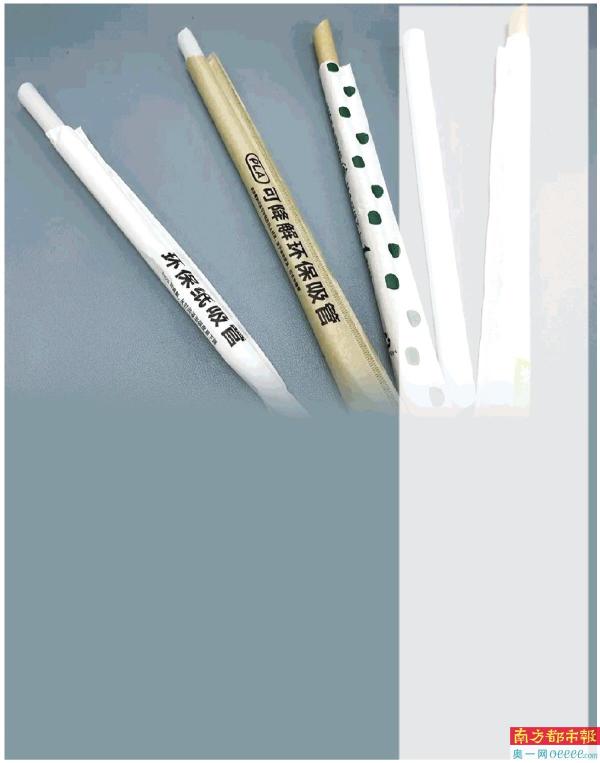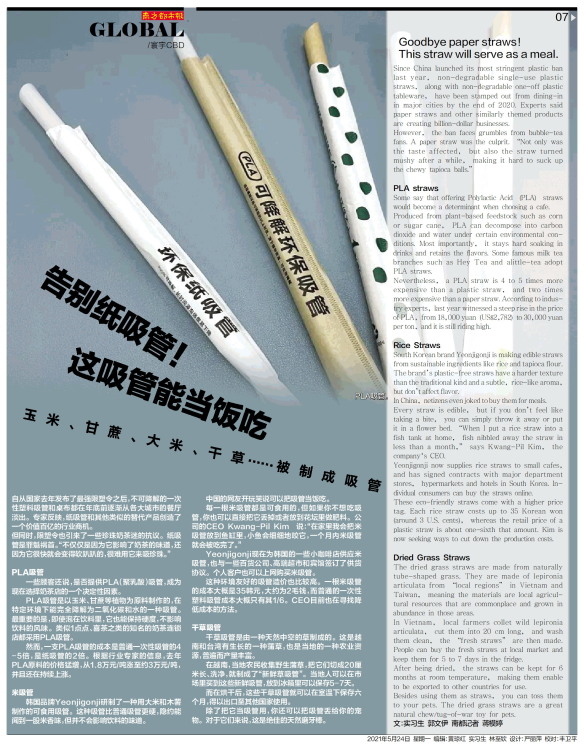
PLA吸管。
自从国家去年发布了最强限塑令之后,不可降解的一次性塑料吸管和桌布都在年底前逐渐从各大城市的餐厅淡出。专家反映,纸吸管和其他类似的替代产品创造了一个价值百亿的行业商机。
但同时,限塑令也引来了一些珍珠奶茶迷的抗议。纸吸管是罪魁祸首。“不仅仅是因为它影响了奶茶的味道,还因为它很快就会变得软趴趴的,很难用它来吸珍珠。”
PLA吸管
一些顾客还说,是否提供PLA(聚乳酸)吸管,成为现在选择奶茶店的一个决定性因素。
PLA吸管是以玉米、甘蔗等植物为原料制作的,在特定环境下能完全降解为二氧化碳和水的一种吸管。最重要的是,即使泡在饮料里,它也能保持硬度,不影响饮料的风味。类似1点点、喜茶之类的知名的奶茶连锁店都采用PLA吸管。
然而,一支PLA吸管的成本是普通一次性吸管的4-5倍,是纸吸管的2倍。根据行业专家的信息,去年PLA原料的价格猛增,从1.8万元/吨涨至约3万元/吨,并且还在持续上涨。
米吸管
韩国品牌Yeonjigonji研制了一种用大米和木薯制作的可食用吸管。这种吸管比普通吸管更硬,隐约能闻到一股米香味,但并不会影响饮料的味道。
中国的网友开玩笑说可以把吸管当饭吃。
每一根米吸管都是可食用的,但如果你不想吃吸管,你也可以直接把它丢掉或者放到花坛里做肥料。公司的CEO Kwang-Pil Kim 说:“在家里我会把米吸管放到鱼缸里,小鱼会细细地咬它,一个月内米吸管就会被吃完了。”
Yeonjigonji现在为韩国的一些小咖啡店供应米吸管,也与一些百货公司、高端超市和宾馆签订了供货协议。个人客户也可以上网购买米吸管。
这种环境友好的吸管造价也比较高。一根米吸管的成本大概是35韩元,大约为2毛钱,而普通的一次性塑料吸管成本大概只有其1/6。CEO目前也在寻找降低成本的方法。
干草吸管
干草吸管是由一种天然中空的草制成的。这是越南和台湾有生长的一种蒲草,也是当地的一种农业资源,普遍而产量丰富。
在越南,当地农民收集野生蒲草,把它们切成20厘米长、洗净,就制成了“新鲜草吸管”。当地人可以在市场里买到这些新鲜吸管,放到冰箱里可以保存5-7天。
而在烘干后,这些干草吸管就可以在室温下保存六个月,得以出口至其他国家使用。
除了把它当吸管用,你还可以把吸管丢给你的宠物。对于它们来说,这是绝佳的天然磨牙棒。
Goodbye paper straws!
This straw will serve as a meal.
Since China launched its most stringent plastic ban last year, non-degradable single-use plastic straws, along with non-degradable one-off plastic tableware, have been stamped out from dining-in in major cities by the end of 2020. Experts said paper straws and other similarly themed products are creating billion-dollar businesses.
However, the ban faces grumbles from bubble-tea fans. A paper straw was the culprit. “Not only was the taste affected, but also the straw turned mushy after a while, making it hard to suck up the chewy tapioca balls.”
PLA straws
Some say that offering Polylactic Acid (PLA) straws would become a determinant when choosing a cafe.
Produced from plant-based feedstock such as corn or sugar cane, PLA can decompose into carbon dioxide and water under certain environmental conditions. Most importantly, it stays hard soaking in drinks and retains the flavors. Some famous milk tea branches such as Hey Tea and alittle-tea adopt PLA straws.
Nevertheless, a PLA straw is 4 to 5 times more expensive than a plastic straw, and two times more expensive than a paper straw. According to industry experts, last year witnessed a steep rise in the price of PLA, from 18,000 yuan (US$2,782) to 30,000 yuan per ton, and it is still riding high.
Rice Straws
South Korean brand Yeonjigonji is making edible straws from sustainable ingredients like rice and tapioca flour. The brand’s plastic-free straws have a harder texture than the traditional kind and a subtle, rice-like aroma, but don’t affect flavor.
In China, netizens even joked to buy them for meals.
Every straw is edible, but if you don’t feel like taking a bite, you can simply throw it away or put it in a flower bed. “When I put a rice straw into a fish tank at home, fish nibbled away the straw in less than a month,” says Kwang-Pil Kim, the company‘s CEO.
Yeonjigonji now supplies rice straws to small cafes, and has signed contracts with major department stores, hypermarkets and hotels in South Korea. Individual consumers can buy the straws online.
These eco-friendly straws come with a higher price tag. Each rice straw costs up to 35 Korean won (around 3 U.S. cents), whereas the retail price of a plastic straw is about one-sixth that amount. Kim is now seeking ways to cut down the production costs.
Dried Grass Straws
The dried grass straws are made from naturally tube-shaped grass. They are made of lepironia articulata from “local regions” in Vietnam and Taiwan, meaning the materials are local agricultural resources that are commonplace and grown in abundance in those areas.
In Vietnam, local farmers collet wild lepironia articulata, cut them into 20 cm long, and wash them clean, the “fresh straws” are then made. People can buy the fresh straws at local market and keep them for 5 to 7 days in the fridge.
After being dried, the straws can be kept for 6 months at room temperature, making them enable to be exported to other countries for use.
Besides using them as straws, you can toss them to your pets. The dried grass straws are a great natural chew/tug-of-war toy for pets.
文:实习生 郭文伊 南都记者 蒋模婷

